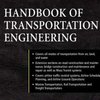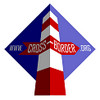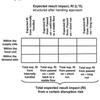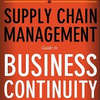 This is an updated and extended review of the Handbook of Transportation Engineering
This is an updated and extended review of the Handbook of Transportation Engineering by Myer Kutz (editor) which I have reviewed in a previous post 4 years ago: Book Review: The Handbook of Tranportation Engineering. While rummaging through references for a journal article I came across an old copy of the chapter on Transportation Engineering in the above book and to my surprise I discovered a recent acquaintance I had forgotten that I already had met 4 years ago: The risk definition by Kaplan & Garrick (1981). For supply chain risk researchers, this risk definition has it all.
Almost 10 years ago
The chapter on Transportation Hazards is written by by Thomas J Cova, Associate Professor at the University of Utah in Salt Lake City and Steven M Conger, who I presume now works with Iteris Inc., a company delivering a range of services within the field of ITS, Intelligent Transportation Systems. Both Tom and Steve are two personal acquaintances of mine, who I met while at the UofU during 2000-2002, while I attempted, but never finished my PhD in Geography, although I did develop a GIS tool I called Javalanche, and a spatial framework for analyzing hazards to transportation lifelines. Tom was in fact my PhD supervisor. And is their chapter on Transportation Hazards a worthwhile read? Yes, and perhaps a little bit No. In this post I will explain why.
Kaplan revisited
What is interesting to me now is that in their discussion risk and vulnerability, Cova and Conger use the risk definition of Kaplan & Garrick (1981). This risk definition was later championed by Paulsson (2007) with his DRISC model and it is also the risk definition used in my research on supply chain disruptions in sparse transportation networks, and strangely, I did not recall Cova & Conger when reading Paulsson. The definition splits the concept of risk into three different elements, together called a triplet. Each triplet identifies a risk scenario, involving a source, a likelihood and an impact:
- What can happen and what is the cause?
- How likely is it that it will happen?
- If it does happen, what are the consequences?
A risk can be seen as incompletely described unless all three elements are in place. An untrained individual or business entity often stops short after the first, or maybe the second question, without fully considering the third. In risk management, addressing the impacts is an important issue, which is why the consequences need to be considered along with the likelihood and source of risk.
Natural hazards only?
My definition of a ‘hazard’ is literally wide open and looking at it now I find it limiting that the chapter deals with environmental or natural hazards only (1st limitation). That said, these hazards make up a major part of the adverse factors that can affect transportation, and in the case of this chapter, road transportation only (2nd limitation). The list of hazards and abatement measures discussed in greater or lesser detail in this chapter include:
- Avalanches
- Earthquakes
- Flods and Dam Breaks
- Fog, Dust, Smoke, Sunlight and Darkness
- Rain, Snow and Ice
- Landslides, Rock fall, and Debris Flow
- Wind, Tornadoes and Hurricanes
- Wildlife
The chapter also touches briefly on transportation itself as a hazard (i.e. accidents) and also look at emergency or evacuation requirements for transportation.
Concise but exhaustive
What is most impressive to me, is the extensive reference list in this chapter, some 150 references to relating literature. So even if the chapter itself has its limitations, the reference list provides ample options for in-depth research. After all, how much can you put into a 24-page chapter in a 1000-page book? The chapter is concise and two the point and that is what is needed for a handbook.
Conclusion
While the book comes with a hefty price, it is worth it. I have not studied the other chapters that extensively, but flipping through the pages, they did look similar: a ‘short’ chapter with a solid reference list.
Reference
Cova, T. J., & Conger, S. M. (2004). Transportation Hazards. In M. Kutz (Ed.), Handbook of Transportation Engineering (pp. 17.11-17.24). New York: McGraw-Hill.
Kaplan, S., & Garrick, B. (1981). On The Quantitative Definition of Risk Risk Analysis, 1 (1), 11-27 DOI: 10.1111/j.1539-6924.1981.tb01350.x
Author links
- geog.utah.edu: Thomas J Cova
amazon.com
- Buy this book at amazon: Handbook of Transportation Engineering
Related
- husdal.com: The DRISC model
- husdal.com: Supply chain disruptions in sparse transportation networks











